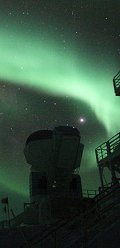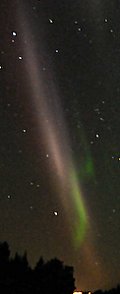| |
Summary:
On July 5th, the interplanetary magnetic field (IMF) near Earth
tipped south, opening a
crack in Earth's magnetic defenses against the solar wind.
Solar wind poured in and fueled a bright display of Southern Lights.
A solar wind stream crashed into Earth's magnetic field on July
12th, causing a similar display of Northern Lights over Canada.
See also June 2008.
|
 |
| |
| |
Photographer,
Location |
Images |
Comments |
|

|
Bob,
Saskatoon, Saskatchewan, Canada
Jul. 12, 2008 |
#1,
#2 |
I was called
on the phone and emailed from Spaceweatherphone.com
stating there was a mild geomagnetic storm going on in my
area. Thanks to this alert I got some beautiful images of
Aurora's just outside of Saskatoon, Sk. Even got some images
complete with meteors.
Photo
details: Canon
40D, 30 second exposure and an ISO of 1600. |
|

|
Dale Nosko,
Edmonton, Alberta, Canada
Jul. 11, 2008 |
#1,
more |
Solar minimum
aside, wow! A short-lived but nice display.
Photo
details: Canon
400D, 30" exposure, f5, 200 ISO. |
|


|
J. Dana Hrubes,
The geographic south pole, 90 S Latitude
Jul. 5, 2008 |
#1,
#2, more |
Imagine
walking a mile to work every day in pitch-black dark with
air temperatures routinely dipping below -90 F. It might
be worth it if you could look up and see this.
These pictures
come from Earth's south pole where "we had a nice display
of aurora australis on July 5th," says J. Dana Hrubes,
science leader of the Amundsen-Scott Station. Just before
he took the picture, the interplanetary magnetic field (IMF)
near Earth tipped south, opening a crack in our planet's
magnetosphere. Solar wind poured in and fueled the auroras.
"That's Jupiter shining just above the silhouette of
the South Pole Telescope," he points out.
Every
day, Hrubes walks a mile from the main station to the telescope.
"This gives me plenty of time to gaze at the sky. The
temperature was -84 F when I took today's pictures and I
have taken photos down to a temperature of -110.7 F, which
is my personal all time low in early August, 2005. You have
to take photos as quickly as possible; you never know what
is going to freeze first, your camera or your fingers."
(Note to cold-weather photographers: Hrubes uses a Canon
400D.)
"We are
now getting into the coldest months, July and August, where
we will see temperatures below -100 F," he continues.
"These are actual static temperatures, not wind chills.
Furthermore, the elevation of the site is nearly 10,000
feet and we experience physiological altitudes between 10,500
ft and 12,200 ft during winter." Many people would
be put off by such conditions, but not Hrubes. "In
four years at the Pole, I have racked up more than 3,000
miles of walking. I am lucky to have a great walk like this
to my job 7 days a week." |
|

|
Valter Binotto,
Baie-Comeau Quebec Canada
Jul. 11, 2008 |
#1,
more |
During my holidays
in Canada last week I finally saw an unexpected aurora (for
the first time!!)
Photo
details: Nikon
D300 ob. Nikon 16/85 at 16mm f3.5 esp 30 sec. iso 1250
|
|
|
more images: from
Baptiste Lacoste of Tadoussac, Quebec, Canada |